Create an OIDC Connector
The OpenID Connect (OIDC) connector allows SigningHub to connect with any third-party authentication service that supports OIDC protocol such as Google and Azure Active Directory. This is a generic configuration so the "Auth URL" provided in the connector will be used for identifying the third-party service configured to authenticate the user both at the time of login and at the time of signing.
Create an OIDC connector:
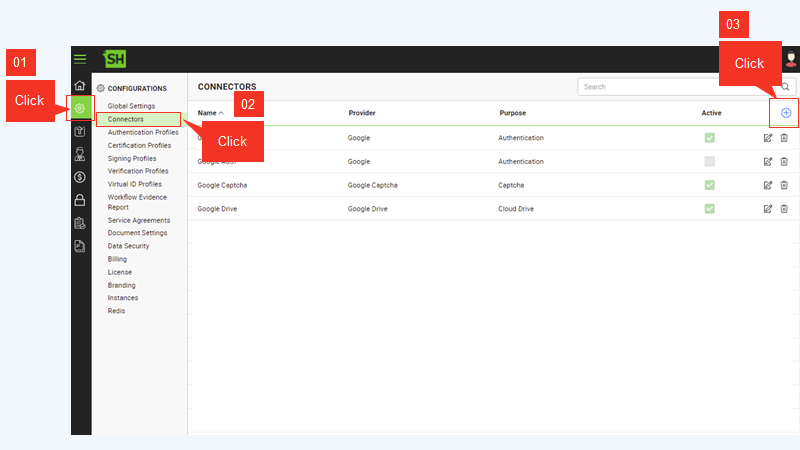
- From the left menu, click "Configurations".
- Click "Connectors" .
- From the top right corner of the connectors list, click
 .
.
The Add Connector dialog is displayed..
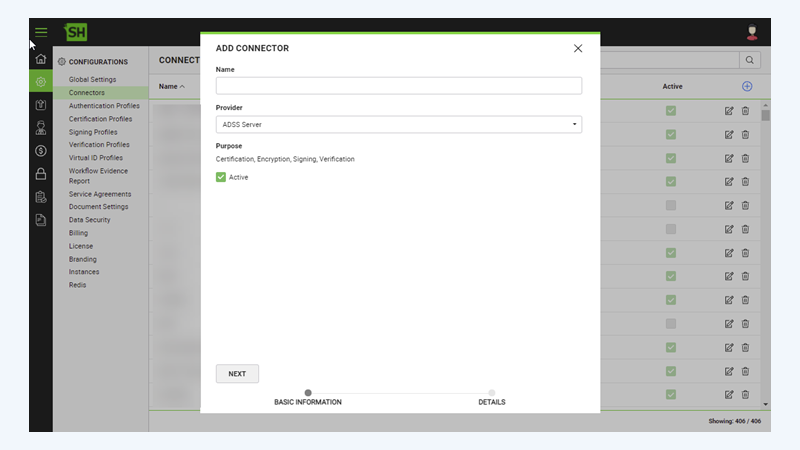
The Add Connector dialog is a step-wise wizard consisting of the following the steps for configuring the connector:
- Basic Information
- Details
On the Basic Information section:
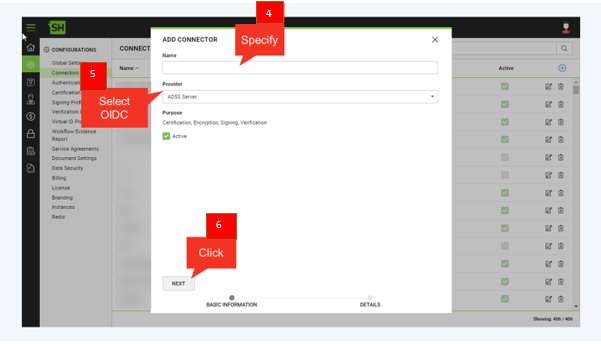
4. Type in a unique Name for the connector.
5. Select "OIDC" in the Provider field.
6. Click Next.
The following image illustrates an example of information entered on the dialog.
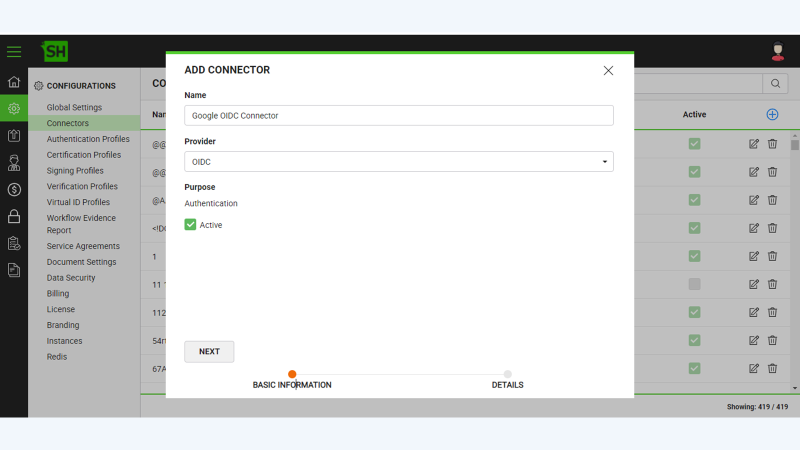
On the Details section:
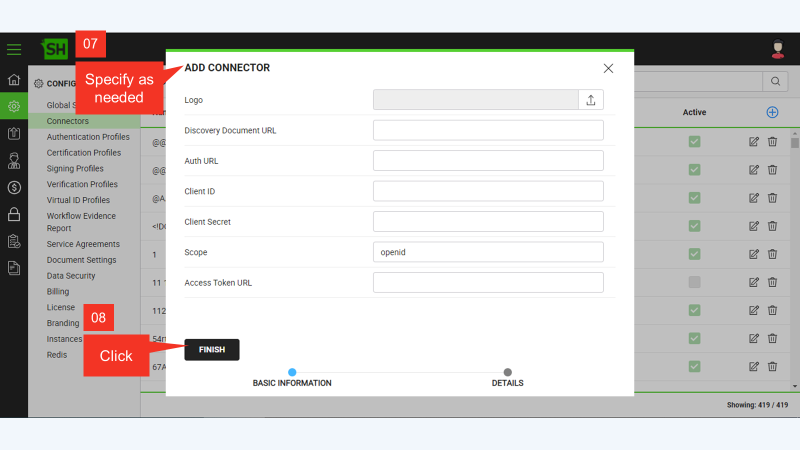
7. Specify the fields as required by the third-party service; leave the rest empty.
8. Click Finish.
The OIDC connector has been added and can be used in an authentication profile.
The following image illustrates the example information entered on the "Details" section of the dialog.
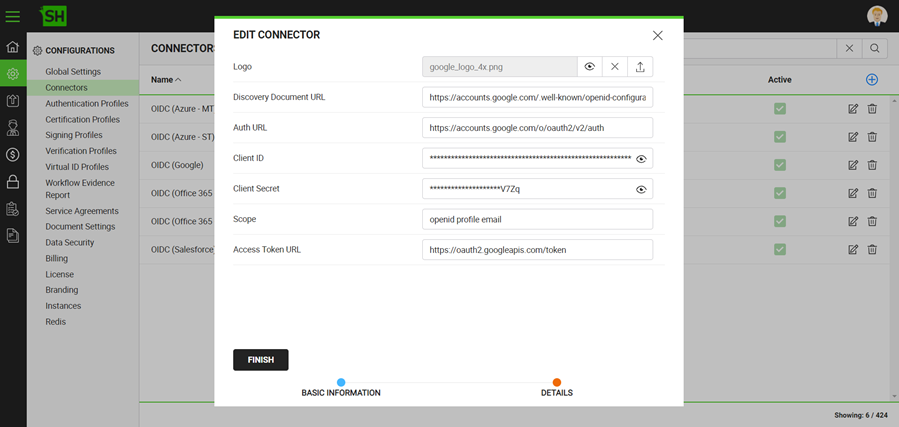
The following table describes the fields on the "Basic Information" section of this dialog.
|
Basic Information Section |
|
|
Fields |
Description |
|
Name |
Specify a unique name for this connector, i.e. My Google. This connector will be used in the configuration of Authentication Profiles. |
|
Provider |
Select the provider for this connector, i.e. "OIDC". |
|
Purpose |
This field will display the purpose of the selected provider above, i.e. the purpose of "OIDC" is "Authentication". |
|
Active |
Select to make this connector active. Keep the check box empty to make the connector In-active. An inactive connector cannot be configured in the Authentication Profiles. |
|
Next |
Displays the "Details" section. |
The following table describes the fields on the "Details" section of this dialog.
|
Details Section |
|
|
Fields |
Description |
|
Logo |
Select an appropriate image in the jpeg, jpg, gif or png format for the connector's logo that will be displayed on the login screen. |
|
Discover Document URL |
Enter the "Discovery Document URL", OpenID Connect defines a discovery mechanism, called OpenID Connect Discovery, where an OpenID server publishes its metadata at a well-known URL, typically |
|
Auth URL |
Enter the endpoint as provided by the third-party authentication server. For example, "https://accounts.google.com/o/oauth2/v2/auth" is for Google. |
|
Client ID |
Enter the registered client ID as provided by the third-party authentication server. By default, the text is masked with asterisks, you can click |
|
Client Secret |
Enter the client secret as provided by the third-party authentication server. By default, the text is masked with asterisks, you can click |
|
Scope |
REQUIRED OpenID Connect requests MUST contain the openid scope value. (its auto filled in field) add more parameters if needed like email, profile (seprated with empty space) |
|
Access Token URL |
Enter the endpoint as provided by the third-party authentication server for exchanging the authorization code for an access token. For example, "https://www.oauth2.googleapis.com/token" is provided by Google. |
|
Finish |
Creates a new connector using the information entered on the dialog. |
See Also
- Create a LinkedIn Connector
- Create a Google Connector
- Create a OneDrive Connector
- Create an ADSS Server Connector
- Create a Clickatell Connector
- Create a Twilio Connector
- Create a Worldpay Connector
- Create a Stripe Connector
- Create an SMTP Server Connector
- Create an Active Directory Connector
- Create a Dropbox Connector
- Create a Salesforce Connector
- Create a SAML IdP Connector
- Create a Google Drive Connector
- Create a HubSpot Connector
- Create an Office 365 Connector
- Create an ADFS Connector
- Create a Maxmind GeoIP Connector
- Create a Firebase Connector
- Create a Freja Mobile Connector
- Create a Freja eID Connector
- Create an Azure Blob Connector
- Create an Azure Active Directory Connector
- Create a Bank ID Connector
- Create a Captcha Connector
- Create an SMS Connector
- Create an itsme Connector
- Create a T1C Connector
- Create a File Scanning Connector
- Create a CSC Connector
- Create an OAuth2.0 Connector
- Edit a Connector
- Delete a Connector
- Search a Connector


